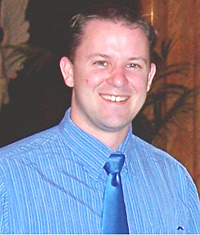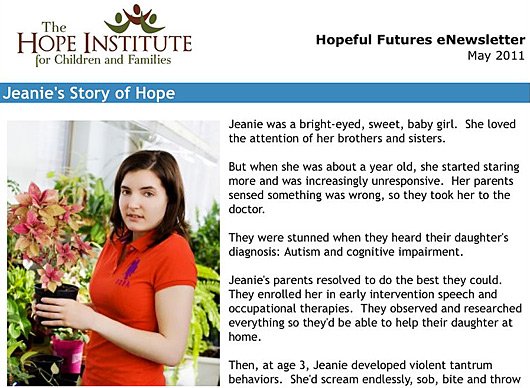
 When nonprofits roll out a social media program, their tendency is to launch a presence on Facebook or Twitter and then treat them simply as new communication or marketing channels.
When nonprofits roll out a social media program, their tendency is to launch a presence on Facebook or Twitter and then treat them simply as new communication or marketing channels.
No, no, a thousand times no!
Of the 1.5 million charities in this country, perhaps 99 out of 100 go about using social media the wrong way, as a stand-alone tactic. The right way, as we tell our nonprofit clients, is to roll out a social media plan where all of the channels begin to work with each other in an integrated, aligned, complementary, strategic fashion.
Easier said than done, right? But one nonprofit that seems to be doing this well is worth a close look: The Hope Institute for Children and Families of Springfield, Illinois. It’s a midsize nonprofit that provides educational, residential and health services to children ages 5-21 with multiple developmental disabilities, including autism spectrum disorders.
Building out a digital marketing platform

I chatted the other day with Jarid A. Brown, who runs online interactions for Hope (which I’ll use as a shorthand here for the organization that runs education centers, residential services, a children’s home and a school in Chicago, among other things). Hope brought on Jarid 18 months ago to create a digital marketing platform.
“Our first task was to decide how to make the website, social media, event marketing and direct mail all work together,” he said by phone. “Because they weren’t. We had a traditional information-based website, all very technical and clinical with no opportunity for people to interact. It was basically a very thorough online brochure with no considerations of marketing.”
Jarid set about making changes. Hope began to integate Australia-based Prosper, a customer relationship management database, into its email marketing and event marketing activities and began using Constant Contact for email marketing. Most importantly, he made sure that social media, direct mail and events put on by Development all began working in tandem.
— Jarid A. Brown
“Everything we do online is all interrelated now,” he said. A monthly direct mail appeal goes out to 150,000-250,000 people, typically centered around the story of one of the children at Hope. “On the day it arrives in people’s mailboxes, the story is posted on our blog and an e-newsletter goes out that points to it.”
Hope also holds three major fundraising events during the year: a fashion show in March with up to 700 attendees, a dinner in April with about 450 guests and a celebrity chef event in September that draws 300. Each receives pre- and post-event coverage on Facebook and Twitter.
That’s only a glimpse of Hope’s online and offline activities, which add up to a successful marketing strategy.
Said Brown: “The bottom line is that email and social media are not an either or proposition. They have to work together. Everything we do on Facebook is part of a larger campaign. Part of the problem with some nonprofits is that they aren’t making the tools work together. When you combine these online tools, you are able to tell a much more powerful story with exponentially greater results.”
Metrics tell the success story

Metrics tell the tale. “It’s been incredible,” Jarid said. “Every metric we track shows that readership and engagement continue to rise at phenomenal rates — and it’s all being done organically. Our online donations are experiencing huge growth, in the hundreds of percent. Our event attendance has risen, the number of news stories read has risen. I could go on and on.”
Hope has seen the following increases in a little more than a year:
- Facebook Page fans rose from about 400 to about 4,500 on the Hope Institute Page (2,286 Likes) and The Autism Program of Illinois Page (TAP, 2,212 Likes).
- Twitter went from a couple of dozen followers to 1,638 for the Hope Institute and 2,511 for the TAP program.
- Views on Hope’s YouTube channel increased from a total of 3,000 to 100,000.
- Event attendance has also grown by nearly 20%. Since integrating Constant Contact Event Marketing tools into their online marketing platform, Hope now collects 15 percent of overall donations and event registrations online.
- The e-newsletter has shot up to 3,300 subscribers. (Subscribe to it here; it’s impressive.)
Hope also won two of the Pepsi Refresh Challenge Grant contests online last year and may do something similar for the Toyota 100 Cars For Good contest this summer.
Keep an eye on the Hope Institute and this Jarid guy before he leap-frog all of us. Connect with Jarid on Twitter or LinkedIn.JD Lasica, founder and former editor of Socialbrite, is co-founder of Cruiseable. Contact JD or follow him on Twitter or Google Plus.









Terrific article. It appears that Hope has embarked on a strategy that will help kids with disabilities in a very positive way. Great work.